Economic Analysis of Oligopoly in Australia's Banking Sector
VerifiedAdded on 2023/06/13
|8
|1527
|142
Report
AI Summary
This report provides an economic analysis of the oligopolistic structure prevalent in the Australian banking sector, focusing on the market power held by the four major banks and its implications for competition and consumer welfare. Referring to a Reuters article on the Australian Competition and Consumer Commission's (ACCC) review of the banking sector, the report examines how these banks control a significant portion of the residential lending market and exhibit accommodative oligopoly behavior. It delves into the economic concepts of oligopoly, including price wars and cartel formation, and discusses the potential detrimental effects on customers and smaller supply-side providers. The report concludes by highlighting the ACCC's decision to review the market power of these banks to address the lack of competitive environment in the Australian banking sector, suggesting measures to foster a more balanced and competitive industry landscape. The analysis uses economic theory and real-world observations to provide a comprehensive understanding of the Australian banking market.
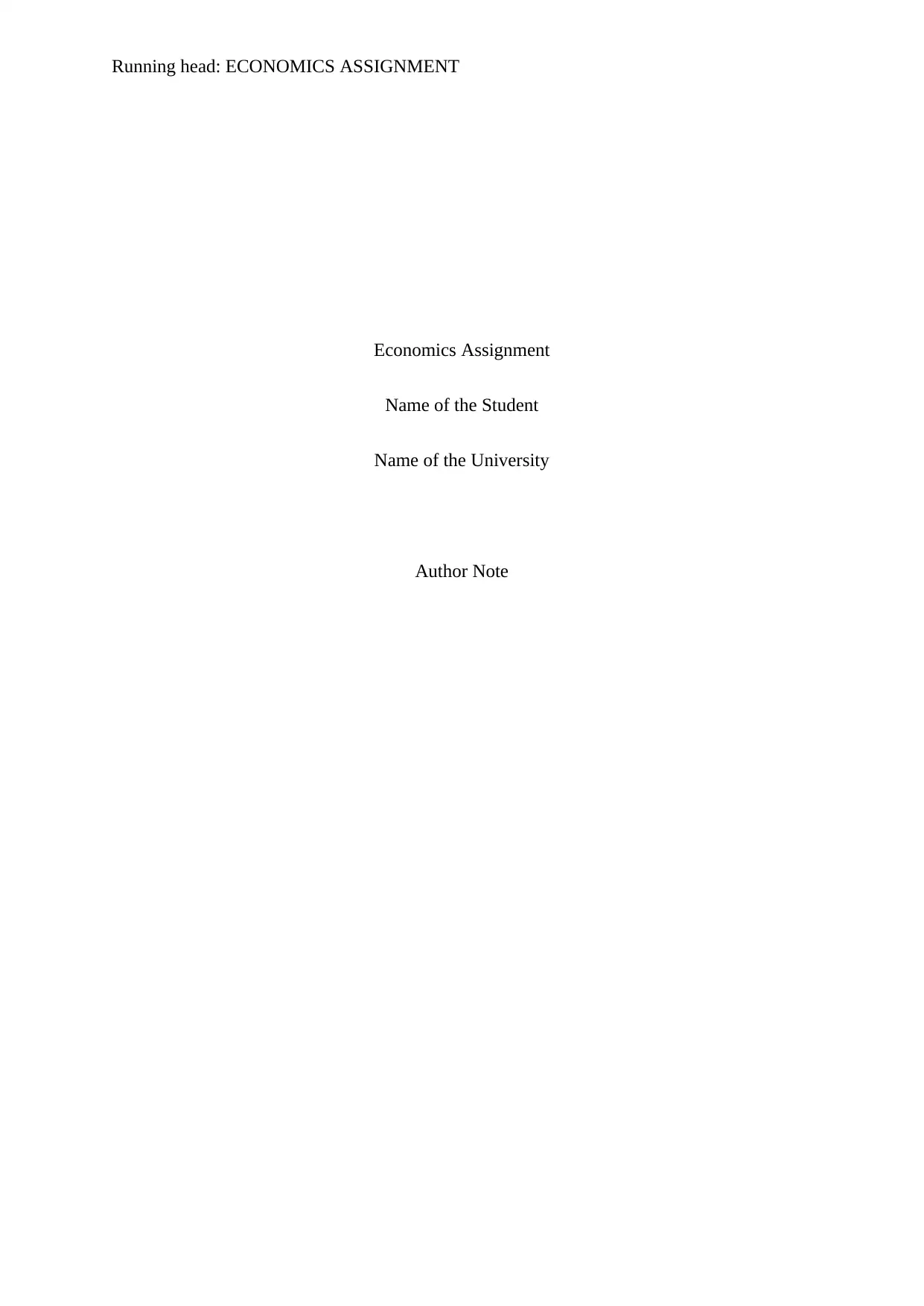
Running head: ECONOMICS ASSIGNMENT
Economics Assignment
Name of the Student
Name of the University
Author Note
Economics Assignment
Name of the Student
Name of the University
Author Note
Paraphrase This Document
Need a fresh take? Get an instant paraphrase of this document with our AI Paraphraser
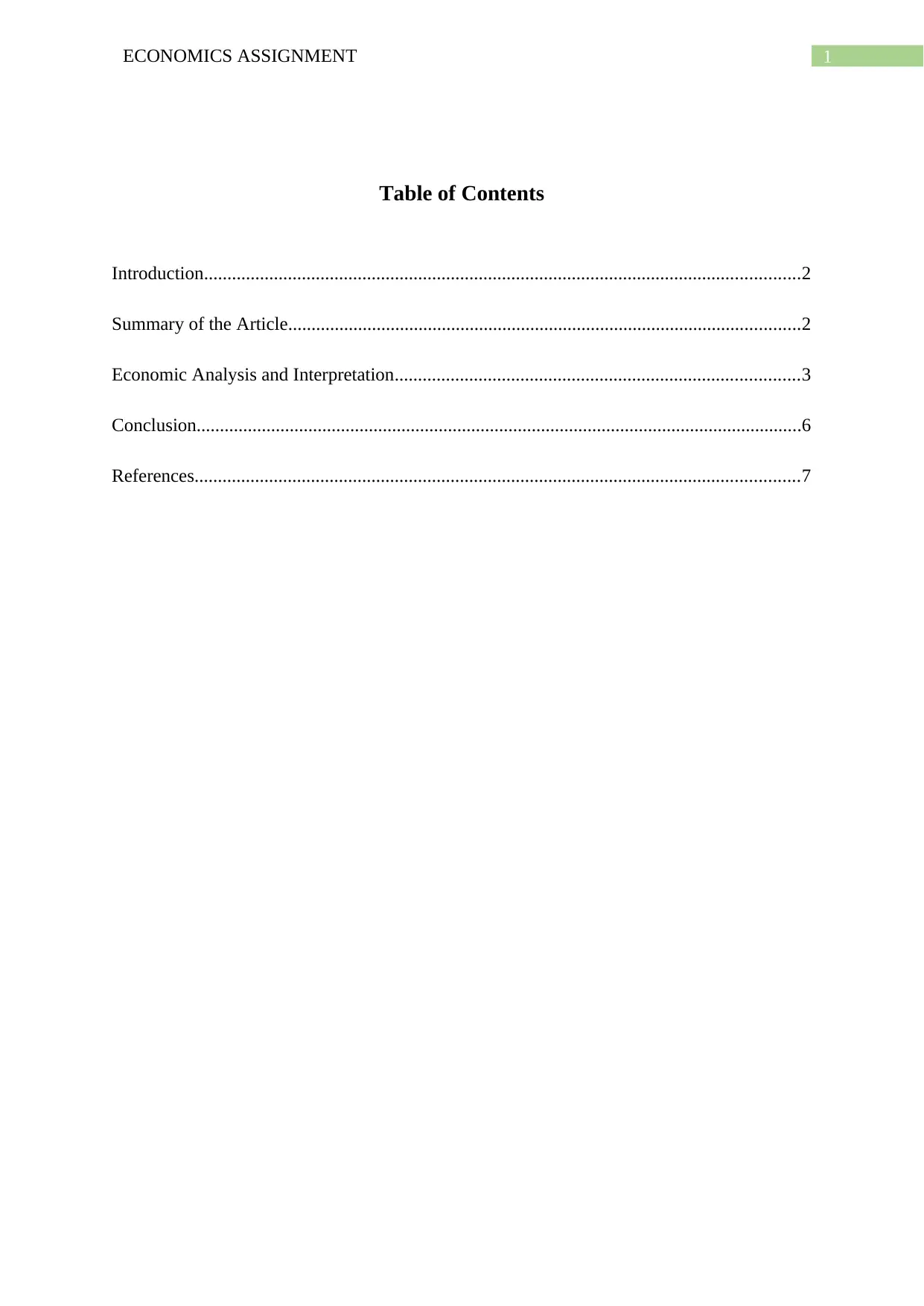
1ECONOMICS ASSIGNMENT
Table of Contents
Introduction................................................................................................................................2
Summary of the Article..............................................................................................................2
Economic Analysis and Interpretation.......................................................................................3
Conclusion..................................................................................................................................6
References..................................................................................................................................7
Table of Contents
Introduction................................................................................................................................2
Summary of the Article..............................................................................................................2
Economic Analysis and Interpretation.......................................................................................3
Conclusion..................................................................................................................................6
References..................................................................................................................................7
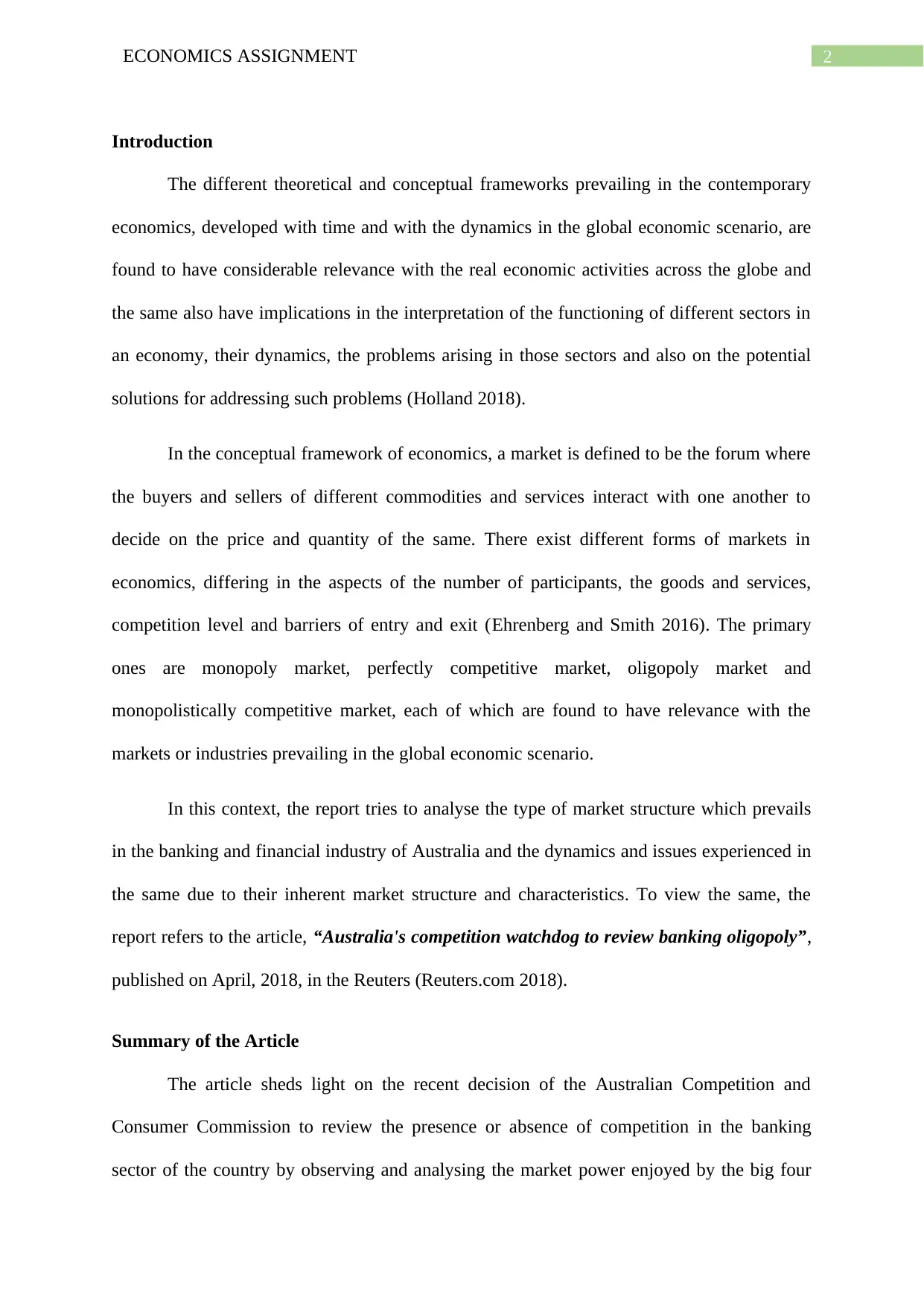
2ECONOMICS ASSIGNMENT
Introduction
The different theoretical and conceptual frameworks prevailing in the contemporary
economics, developed with time and with the dynamics in the global economic scenario, are
found to have considerable relevance with the real economic activities across the globe and
the same also have implications in the interpretation of the functioning of different sectors in
an economy, their dynamics, the problems arising in those sectors and also on the potential
solutions for addressing such problems (Holland 2018).
In the conceptual framework of economics, a market is defined to be the forum where
the buyers and sellers of different commodities and services interact with one another to
decide on the price and quantity of the same. There exist different forms of markets in
economics, differing in the aspects of the number of participants, the goods and services,
competition level and barriers of entry and exit (Ehrenberg and Smith 2016). The primary
ones are monopoly market, perfectly competitive market, oligopoly market and
monopolistically competitive market, each of which are found to have relevance with the
markets or industries prevailing in the global economic scenario.
In this context, the report tries to analyse the type of market structure which prevails
in the banking and financial industry of Australia and the dynamics and issues experienced in
the same due to their inherent market structure and characteristics. To view the same, the
report refers to the article, “Australia's competition watchdog to review banking oligopoly”,
published on April, 2018, in the Reuters (Reuters.com 2018).
Summary of the Article
The article sheds light on the recent decision of the Australian Competition and
Consumer Commission to review the presence or absence of competition in the banking
sector of the country by observing and analysing the market power enjoyed by the big four
Introduction
The different theoretical and conceptual frameworks prevailing in the contemporary
economics, developed with time and with the dynamics in the global economic scenario, are
found to have considerable relevance with the real economic activities across the globe and
the same also have implications in the interpretation of the functioning of different sectors in
an economy, their dynamics, the problems arising in those sectors and also on the potential
solutions for addressing such problems (Holland 2018).
In the conceptual framework of economics, a market is defined to be the forum where
the buyers and sellers of different commodities and services interact with one another to
decide on the price and quantity of the same. There exist different forms of markets in
economics, differing in the aspects of the number of participants, the goods and services,
competition level and barriers of entry and exit (Ehrenberg and Smith 2016). The primary
ones are monopoly market, perfectly competitive market, oligopoly market and
monopolistically competitive market, each of which are found to have relevance with the
markets or industries prevailing in the global economic scenario.
In this context, the report tries to analyse the type of market structure which prevails
in the banking and financial industry of Australia and the dynamics and issues experienced in
the same due to their inherent market structure and characteristics. To view the same, the
report refers to the article, “Australia's competition watchdog to review banking oligopoly”,
published on April, 2018, in the Reuters (Reuters.com 2018).
Summary of the Article
The article sheds light on the recent decision of the Australian Competition and
Consumer Commission to review the presence or absence of competition in the banking
sector of the country by observing and analysing the market power enjoyed by the big four
⊘ This is a preview!⊘
Do you want full access?
Subscribe today to unlock all pages.

Trusted by 1+ million students worldwide
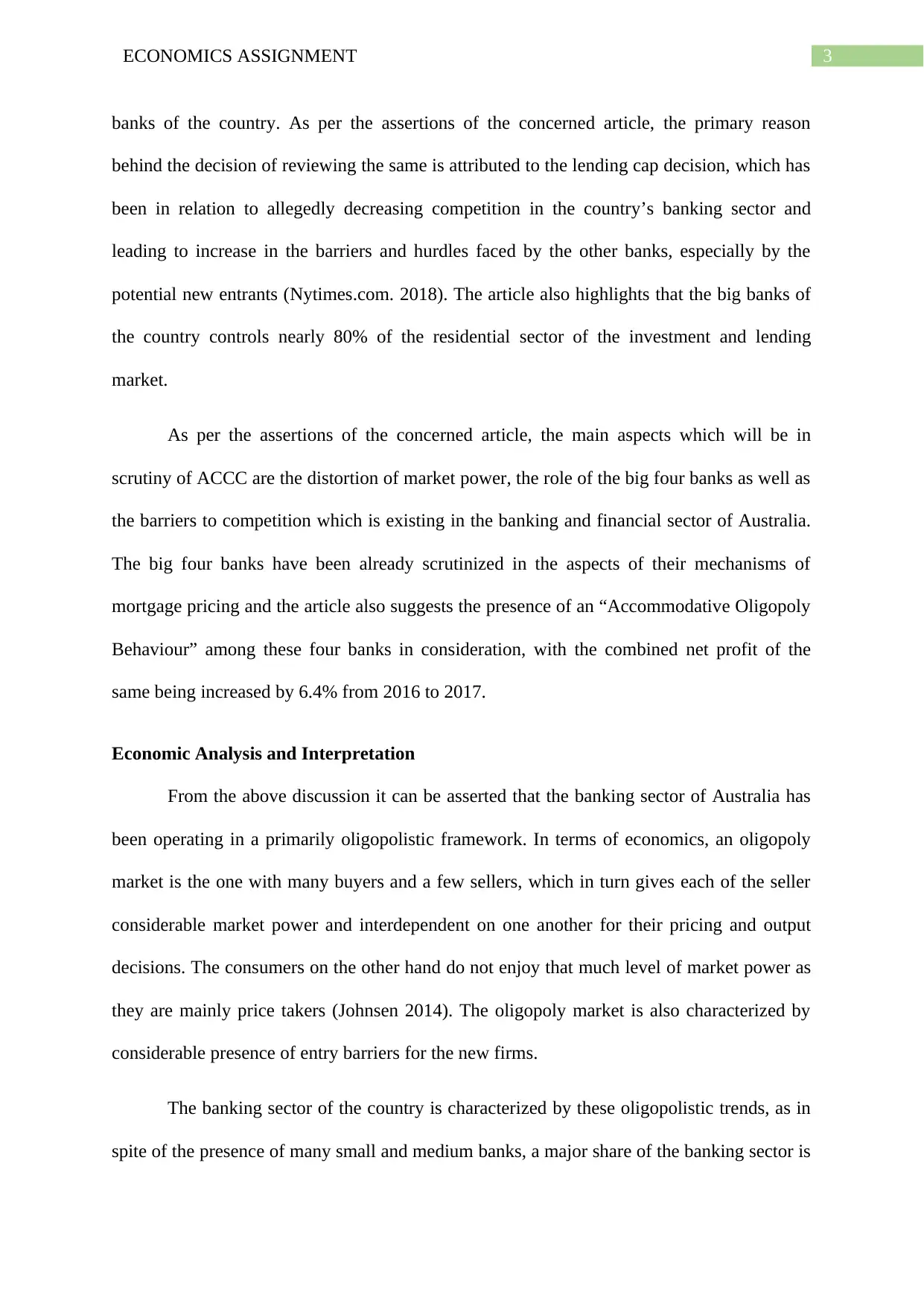
3ECONOMICS ASSIGNMENT
banks of the country. As per the assertions of the concerned article, the primary reason
behind the decision of reviewing the same is attributed to the lending cap decision, which has
been in relation to allegedly decreasing competition in the country’s banking sector and
leading to increase in the barriers and hurdles faced by the other banks, especially by the
potential new entrants (Nytimes.com. 2018). The article also highlights that the big banks of
the country controls nearly 80% of the residential sector of the investment and lending
market.
As per the assertions of the concerned article, the main aspects which will be in
scrutiny of ACCC are the distortion of market power, the role of the big four banks as well as
the barriers to competition which is existing in the banking and financial sector of Australia.
The big four banks have been already scrutinized in the aspects of their mechanisms of
mortgage pricing and the article also suggests the presence of an “Accommodative Oligopoly
Behaviour” among these four banks in consideration, with the combined net profit of the
same being increased by 6.4% from 2016 to 2017.
Economic Analysis and Interpretation
From the above discussion it can be asserted that the banking sector of Australia has
been operating in a primarily oligopolistic framework. In terms of economics, an oligopoly
market is the one with many buyers and a few sellers, which in turn gives each of the seller
considerable market power and interdependent on one another for their pricing and output
decisions. The consumers on the other hand do not enjoy that much level of market power as
they are mainly price takers (Johnsen 2014). The oligopoly market is also characterized by
considerable presence of entry barriers for the new firms.
The banking sector of the country is characterized by these oligopolistic trends, as in
spite of the presence of many small and medium banks, a major share of the banking sector is
banks of the country. As per the assertions of the concerned article, the primary reason
behind the decision of reviewing the same is attributed to the lending cap decision, which has
been in relation to allegedly decreasing competition in the country’s banking sector and
leading to increase in the barriers and hurdles faced by the other banks, especially by the
potential new entrants (Nytimes.com. 2018). The article also highlights that the big banks of
the country controls nearly 80% of the residential sector of the investment and lending
market.
As per the assertions of the concerned article, the main aspects which will be in
scrutiny of ACCC are the distortion of market power, the role of the big four banks as well as
the barriers to competition which is existing in the banking and financial sector of Australia.
The big four banks have been already scrutinized in the aspects of their mechanisms of
mortgage pricing and the article also suggests the presence of an “Accommodative Oligopoly
Behaviour” among these four banks in consideration, with the combined net profit of the
same being increased by 6.4% from 2016 to 2017.
Economic Analysis and Interpretation
From the above discussion it can be asserted that the banking sector of Australia has
been operating in a primarily oligopolistic framework. In terms of economics, an oligopoly
market is the one with many buyers and a few sellers, which in turn gives each of the seller
considerable market power and interdependent on one another for their pricing and output
decisions. The consumers on the other hand do not enjoy that much level of market power as
they are mainly price takers (Johnsen 2014). The oligopoly market is also characterized by
considerable presence of entry barriers for the new firms.
The banking sector of the country is characterized by these oligopolistic trends, as in
spite of the presence of many small and medium banks, a major share of the banking sector is
Paraphrase This Document
Need a fresh take? Get an instant paraphrase of this document with our AI Paraphraser
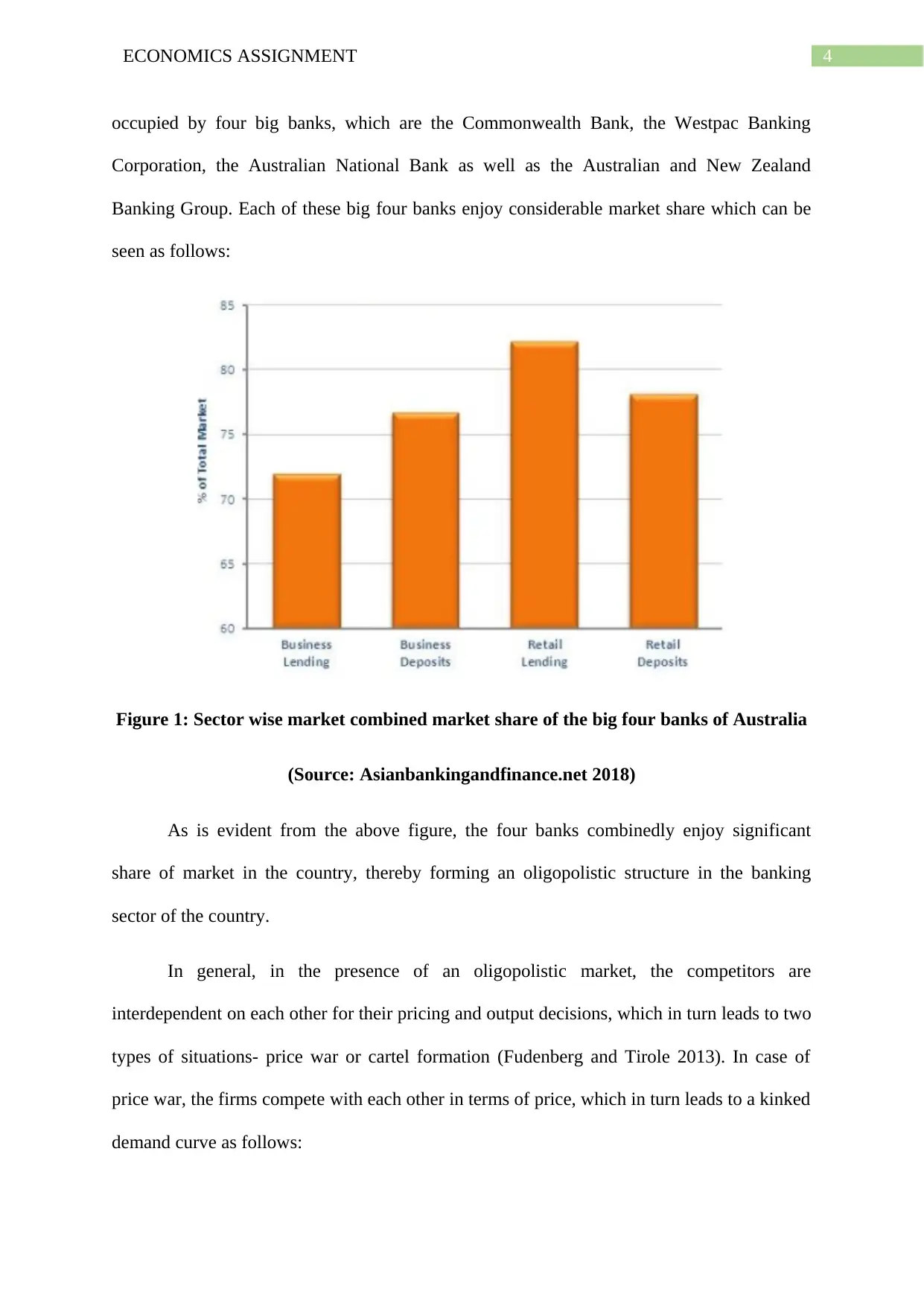
4ECONOMICS ASSIGNMENT
occupied by four big banks, which are the Commonwealth Bank, the Westpac Banking
Corporation, the Australian National Bank as well as the Australian and New Zealand
Banking Group. Each of these big four banks enjoy considerable market share which can be
seen as follows:
Figure 1: Sector wise market combined market share of the big four banks of Australia
(Source: Asianbankingandfinance.net 2018)
As is evident from the above figure, the four banks combinedly enjoy significant
share of market in the country, thereby forming an oligopolistic structure in the banking
sector of the country.
In general, in the presence of an oligopolistic market, the competitors are
interdependent on each other for their pricing and output decisions, which in turn leads to two
types of situations- price war or cartel formation (Fudenberg and Tirole 2013). In case of
price war, the firms compete with each other in terms of price, which in turn leads to a kinked
demand curve as follows:
occupied by four big banks, which are the Commonwealth Bank, the Westpac Banking
Corporation, the Australian National Bank as well as the Australian and New Zealand
Banking Group. Each of these big four banks enjoy considerable market share which can be
seen as follows:
Figure 1: Sector wise market combined market share of the big four banks of Australia
(Source: Asianbankingandfinance.net 2018)
As is evident from the above figure, the four banks combinedly enjoy significant
share of market in the country, thereby forming an oligopolistic structure in the banking
sector of the country.
In general, in the presence of an oligopolistic market, the competitors are
interdependent on each other for their pricing and output decisions, which in turn leads to two
types of situations- price war or cartel formation (Fudenberg and Tirole 2013). In case of
price war, the firms compete with each other in terms of price, which in turn leads to a kinked
demand curve as follows:
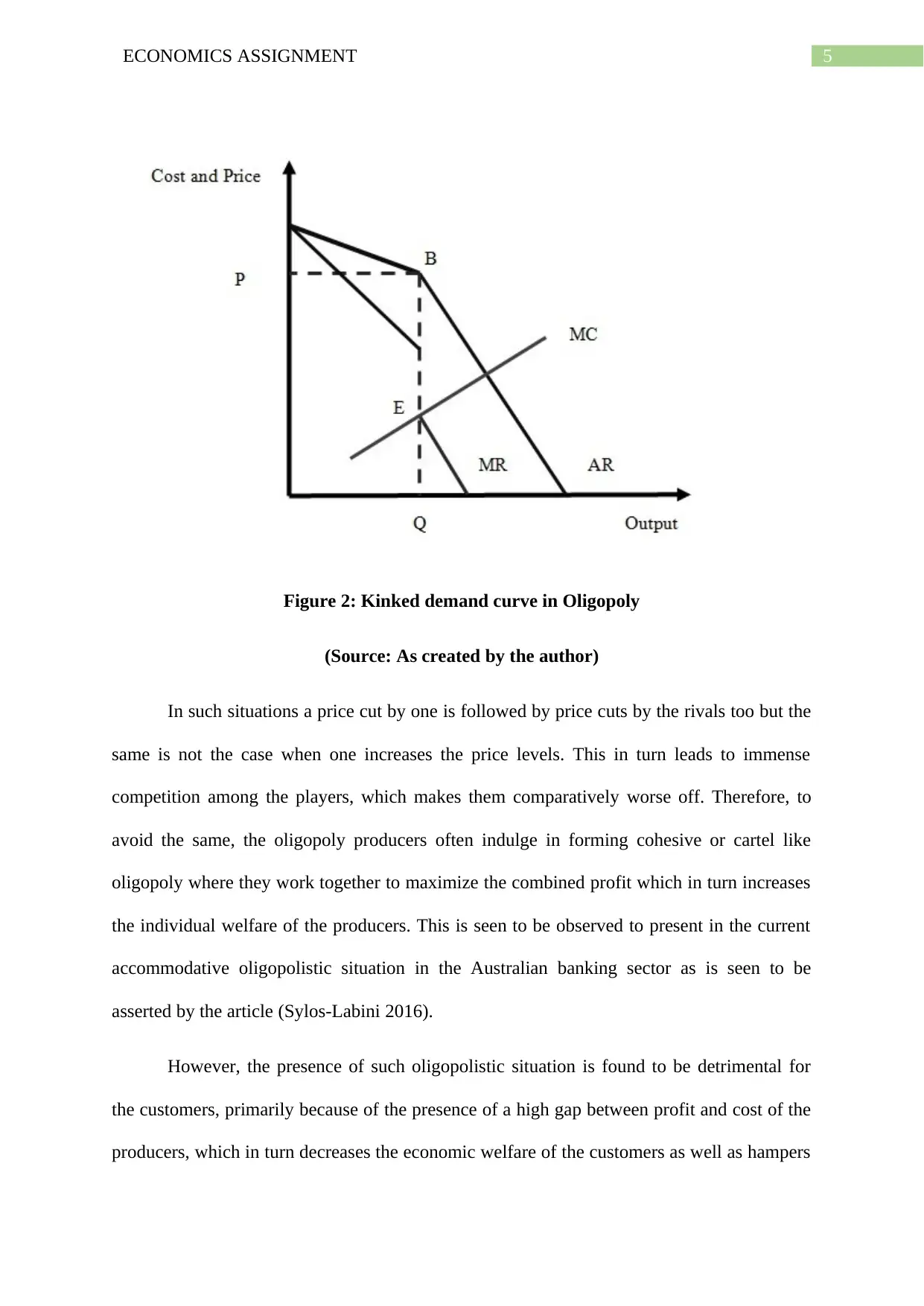
5ECONOMICS ASSIGNMENT
Figure 2: Kinked demand curve in Oligopoly
(Source: As created by the author)
In such situations a price cut by one is followed by price cuts by the rivals too but the
same is not the case when one increases the price levels. This in turn leads to immense
competition among the players, which makes them comparatively worse off. Therefore, to
avoid the same, the oligopoly producers often indulge in forming cohesive or cartel like
oligopoly where they work together to maximize the combined profit which in turn increases
the individual welfare of the producers. This is seen to be observed to present in the current
accommodative oligopolistic situation in the Australian banking sector as is seen to be
asserted by the article (Sylos-Labini 2016).
However, the presence of such oligopolistic situation is found to be detrimental for
the customers, primarily because of the presence of a high gap between profit and cost of the
producers, which in turn decreases the economic welfare of the customers as well as hampers
Figure 2: Kinked demand curve in Oligopoly
(Source: As created by the author)
In such situations a price cut by one is followed by price cuts by the rivals too but the
same is not the case when one increases the price levels. This in turn leads to immense
competition among the players, which makes them comparatively worse off. Therefore, to
avoid the same, the oligopoly producers often indulge in forming cohesive or cartel like
oligopoly where they work together to maximize the combined profit which in turn increases
the individual welfare of the producers. This is seen to be observed to present in the current
accommodative oligopolistic situation in the Australian banking sector as is seen to be
asserted by the article (Sylos-Labini 2016).
However, the presence of such oligopolistic situation is found to be detrimental for
the customers, primarily because of the presence of a high gap between profit and cost of the
producers, which in turn decreases the economic welfare of the customers as well as hampers
⊘ This is a preview!⊘
Do you want full access?
Subscribe today to unlock all pages.

Trusted by 1+ million students worldwide
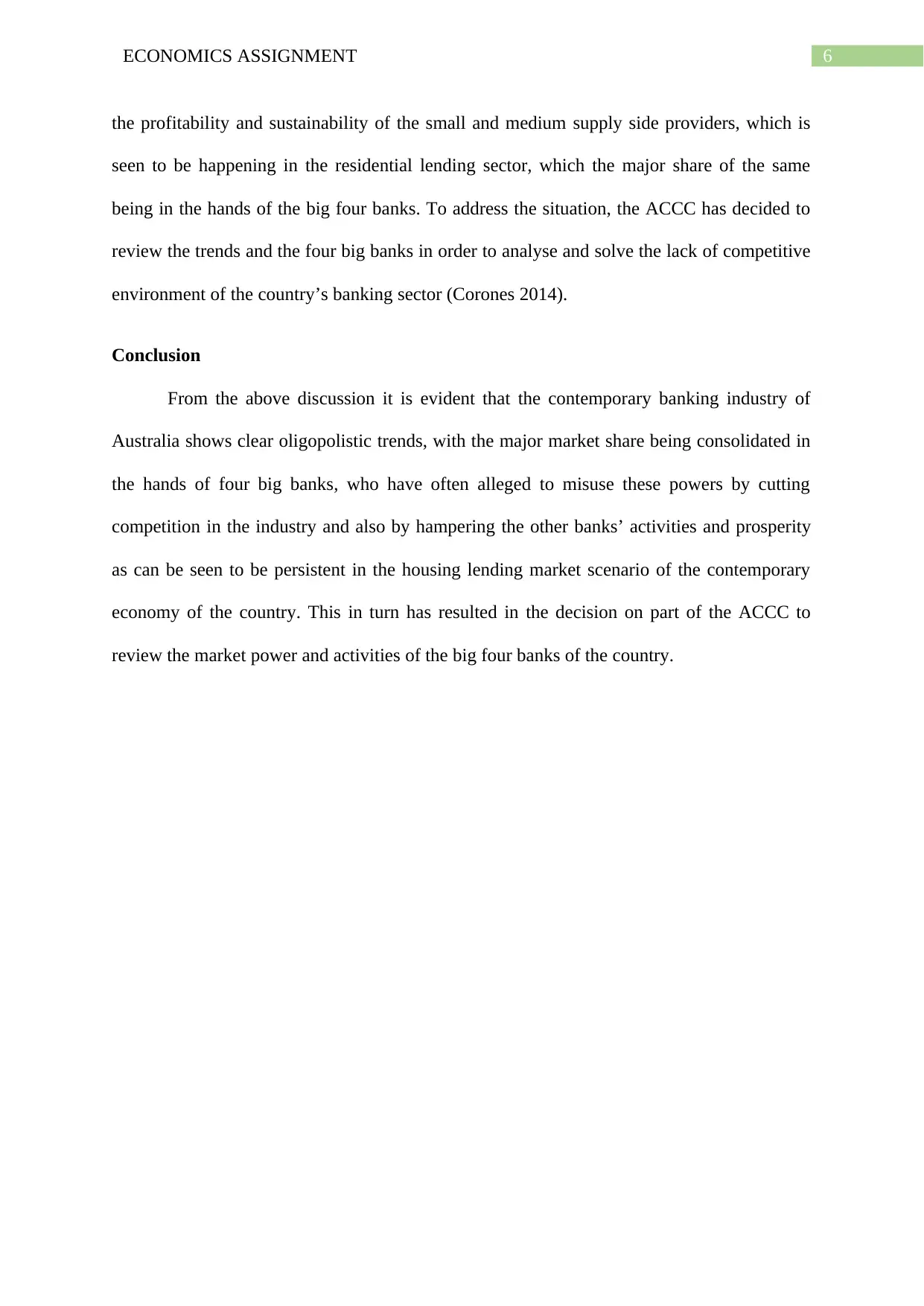
6ECONOMICS ASSIGNMENT
the profitability and sustainability of the small and medium supply side providers, which is
seen to be happening in the residential lending sector, which the major share of the same
being in the hands of the big four banks. To address the situation, the ACCC has decided to
review the trends and the four big banks in order to analyse and solve the lack of competitive
environment of the country’s banking sector (Corones 2014).
Conclusion
From the above discussion it is evident that the contemporary banking industry of
Australia shows clear oligopolistic trends, with the major market share being consolidated in
the hands of four big banks, who have often alleged to misuse these powers by cutting
competition in the industry and also by hampering the other banks’ activities and prosperity
as can be seen to be persistent in the housing lending market scenario of the contemporary
economy of the country. This in turn has resulted in the decision on part of the ACCC to
review the market power and activities of the big four banks of the country.
the profitability and sustainability of the small and medium supply side providers, which is
seen to be happening in the residential lending sector, which the major share of the same
being in the hands of the big four banks. To address the situation, the ACCC has decided to
review the trends and the four big banks in order to analyse and solve the lack of competitive
environment of the country’s banking sector (Corones 2014).
Conclusion
From the above discussion it is evident that the contemporary banking industry of
Australia shows clear oligopolistic trends, with the major market share being consolidated in
the hands of four big banks, who have often alleged to misuse these powers by cutting
competition in the industry and also by hampering the other banks’ activities and prosperity
as can be seen to be persistent in the housing lending market scenario of the contemporary
economy of the country. This in turn has resulted in the decision on part of the ACCC to
review the market power and activities of the big four banks of the country.
Paraphrase This Document
Need a fresh take? Get an instant paraphrase of this document with our AI Paraphraser
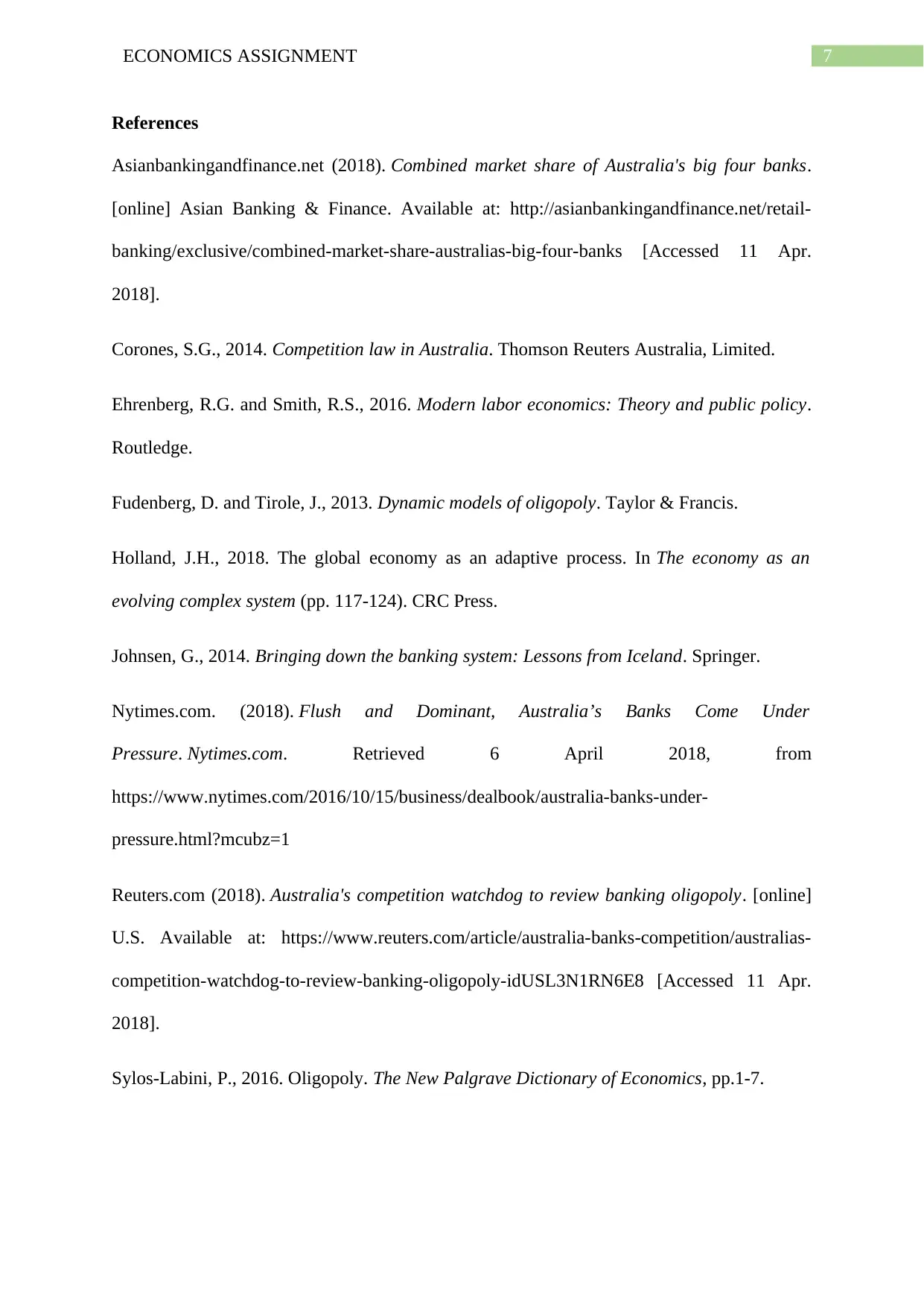
7ECONOMICS ASSIGNMENT
References
Asianbankingandfinance.net (2018). Combined market share of Australia's big four banks.
[online] Asian Banking & Finance. Available at: http://asianbankingandfinance.net/retail-
banking/exclusive/combined-market-share-australias-big-four-banks [Accessed 11 Apr.
2018].
Corones, S.G., 2014. Competition law in Australia. Thomson Reuters Australia, Limited.
Ehrenberg, R.G. and Smith, R.S., 2016. Modern labor economics: Theory and public policy.
Routledge.
Fudenberg, D. and Tirole, J., 2013. Dynamic models of oligopoly. Taylor & Francis.
Holland, J.H., 2018. The global economy as an adaptive process. In The economy as an
evolving complex system (pp. 117-124). CRC Press.
Johnsen, G., 2014. Bringing down the banking system: Lessons from Iceland. Springer.
Nytimes.com. (2018). Flush and Dominant, Australia’s Banks Come Under
Pressure. Nytimes.com. Retrieved 6 April 2018, from
https://www.nytimes.com/2016/10/15/business/dealbook/australia-banks-under-
pressure.html?mcubz=1
Reuters.com (2018). Australia's competition watchdog to review banking oligopoly. [online]
U.S. Available at: https://www.reuters.com/article/australia-banks-competition/australias-
competition-watchdog-to-review-banking-oligopoly-idUSL3N1RN6E8 [Accessed 11 Apr.
2018].
Sylos-Labini, P., 2016. Oligopoly. The New Palgrave Dictionary of Economics, pp.1-7.
References
Asianbankingandfinance.net (2018). Combined market share of Australia's big four banks.
[online] Asian Banking & Finance. Available at: http://asianbankingandfinance.net/retail-
banking/exclusive/combined-market-share-australias-big-four-banks [Accessed 11 Apr.
2018].
Corones, S.G., 2014. Competition law in Australia. Thomson Reuters Australia, Limited.
Ehrenberg, R.G. and Smith, R.S., 2016. Modern labor economics: Theory and public policy.
Routledge.
Fudenberg, D. and Tirole, J., 2013. Dynamic models of oligopoly. Taylor & Francis.
Holland, J.H., 2018. The global economy as an adaptive process. In The economy as an
evolving complex system (pp. 117-124). CRC Press.
Johnsen, G., 2014. Bringing down the banking system: Lessons from Iceland. Springer.
Nytimes.com. (2018). Flush and Dominant, Australia’s Banks Come Under
Pressure. Nytimes.com. Retrieved 6 April 2018, from
https://www.nytimes.com/2016/10/15/business/dealbook/australia-banks-under-
pressure.html?mcubz=1
Reuters.com (2018). Australia's competition watchdog to review banking oligopoly. [online]
U.S. Available at: https://www.reuters.com/article/australia-banks-competition/australias-
competition-watchdog-to-review-banking-oligopoly-idUSL3N1RN6E8 [Accessed 11 Apr.
2018].
Sylos-Labini, P., 2016. Oligopoly. The New Palgrave Dictionary of Economics, pp.1-7.
1 out of 8
Related Documents
Your All-in-One AI-Powered Toolkit for Academic Success.
+13062052269
info@desklib.com
Available 24*7 on WhatsApp / Email
![[object Object]](/_next/static/media/star-bottom.7253800d.svg)
Unlock your academic potential
Copyright © 2020–2025 A2Z Services. All Rights Reserved. Developed and managed by ZUCOL.





